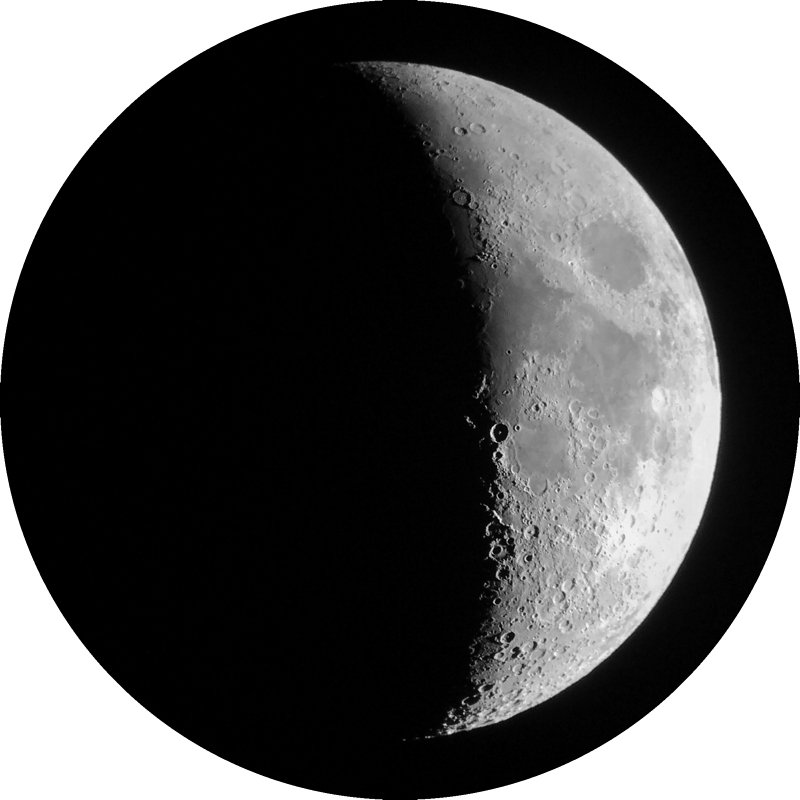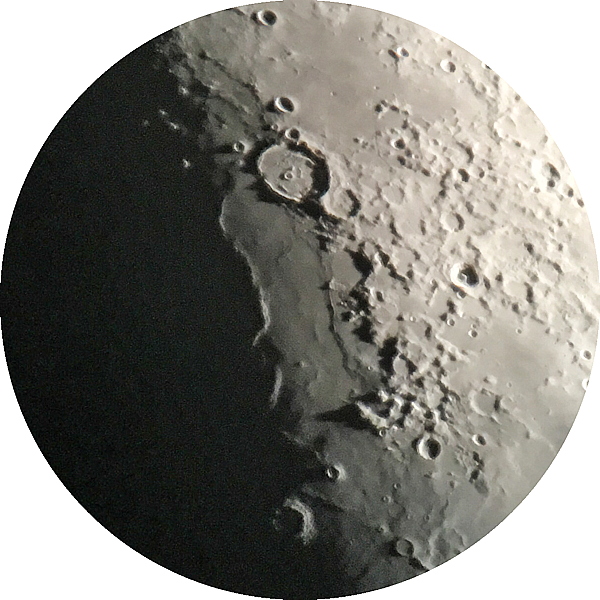More ETX-105 + LXD55 tests;
Imaging: HST, Moon; Critter
Posted: 10 July 2016
|
Open: Saturday, 9 July 2016, 1905 MST Temperature: 98°F |
Session: 995 Conditions: Clear |
Equipment Used:
ETX-105 + LXD55 GEM
1.25" 26mm eyepiece
1.25" 3X TeleXtender
Camera:
D7200 DSLR
iPhone 6s Plus
Once again I set up the ETX-105 mounted on the LXD55 GEM on the observatory patio. I extended the tripod legs to raise the telescope a little higher from its position on the previous night. I also set up the iPhone on a camera tripod using the SteadyPix adapter.

1929 MST: took this handheld photo (full-frame) of the Moon using the D7200 DSLR, f/5.6, 1/500sec, ISO 400, FL 140mm:

1936 MST: sunset. Began preparing for the Hubble Space Telescope (HST) pass. 1942 MST: Jupiter and Mars were now both visible to the naked eye. 1953 MST: Saturn now naked eye visible.
2015 MST: began imaging the HST using the iPhone 6s Plus with NightCap Pro (ISS mode). The twilight sky was still bright. This is the resulting image. The changing brightness of the HST is real. Saturn, Antares, and Mars (trailed during the long exposure) are visible above the HST on the left.

While I was doing the HST imaging a large bird flew over me as I was standing outside of the observatory. It landed on the house roof. After the HST pass was over I got a photo (cropped) using the D7200 DSLR:

Unfortunately, the owl never looked at the camera before flying off.
2025 MST: LXD55 ON. Did an Easy Align. The ETX needed to be higher for convenience when using the finderscope. Will raise it more on the next session. Once I completed the star alignment I viewed the Moon, 57X. I noticed that the star Beta Virginis (Mag. +3.6) was about to be occulted. I quickly mounted the iPhone 6s Plus using the SteadyPix afocal adapter for these photos of the Moon:


I then removed the iPhone and watched the occultation, 57X, which occurred at 2055 MST.
Added the 3X TeleXtender and did some lunar observing at 170X. The rim of Mare Serenitatis showed some nice shadows along the terminator. Mounted the iPhone for this afocal 170X image (cropped from the full-frame image):

Next, I viewed Jupiter and the four Galilean Moons, 170X. Then Mars, 170X. The North Polar Cap, some clouds, and some dark areas were visible. Saturn was a nice view at 170X. Cassini Division and the moon Titan were visible. Using 57X the moons Titan, Rhea, Tethys, and Dione were visible.
2121 MST: LXD55 OFF. I can now declare that using the ETX-105 telescope on the LXD55 GEM is a success. My review of the dovetail and mounting rings will be posted soon.
|
Close: Saturday, 9 July 2016, 2138 MST Temperature: 78°F |
Session Length: 2h 33m Conditions: Clear |
Comments are welcome using Email. Twitter users can use the button below to tweet this report to your followers. Thanks.
Cassiopeia Observatory Home Page
Copyright ©2016 Michael L. Weasner / mweasner@me.com
URL = http://www.weasner.com/co/Reports/2016/07/10/index.html
